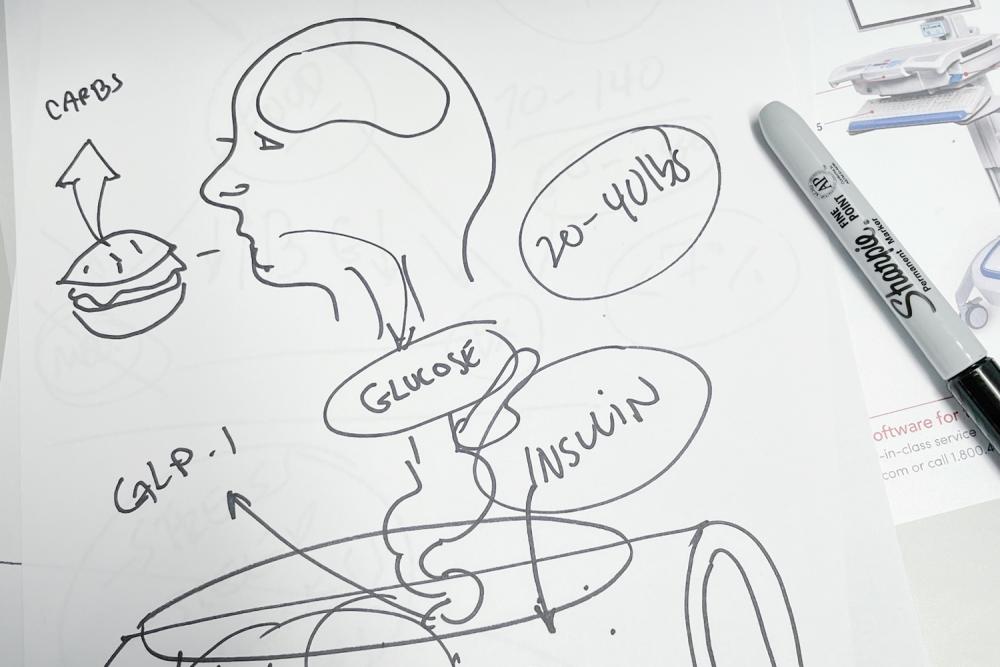
photo: nyu langone staff
In the office of endocrinologist Michael B. Natter, MD, pen-on-paper sketches—a pancreas here, a glucose molecule there—are as commonplace as medical equipment. These illustrations are an integral part of patient care for Dr. Natter, whose educational background includes fine art in addition to medicine.
“I believe every patient has the right to really understand the details of how their disease affects their body,” Dr. Natter explains. “By spending time side by side with my patients, breaking down how things work with detailed drawings, I show them that I am a true partner in their care.”
Speaking a Common Language
Dr. Natter understands exactly what it feels like to be a patient in conversation with a doctor; he was diagnosed with type 1 diabetes at age 9. While hospitalized for diabetic ketoacidosis, a complication of the disease, he developed a fascination with understanding the body’s systems—how they operate, break down, and heal.
Eventually, that fascination carried him to medical school, where his undergraduate education in art led him to doodle everything he learned about anatomy in the margins of his notebooks. He found that the drawings of organs and systems helped the concepts click—he remembered the images of his drawings during tests. The practice naturally went with him as he moved through medical training and into patient care. In addition to seeing patients at the Preston Robert Tisch Center for Men’s Health and NYU Langone Diabetes and Endocrine Associates, Dr. Natter is also a clinical assistant professor in the Department of Medicine and a member of its Division of Endocrinology, Diabetes, and Metabolism at NYU Grossman School of Medicine.
“You flatten all communication barriers when you draw,” he explains. “It makes the information more ‘sticky’ so patients can really understand and remember it. And with that understanding, patients become more empowered in their own care.”
Subway Doors and the Science of Diabetes
Dr. Natter begins every new patient interaction by sharing his own history with type 1 diabetes and asking the patient what they already understand about the disease. There are many patients, he finds, who don’t have an accurate understanding of what it is and how it affects the body.
This is true for people who were diagnosed in childhood and have been living with it for most of their lives, as well as those new to the disease and its treatment regimen. Often, Dr. Natter says, these patients have an overly simple view of diabetes: they understand they should avoid sugar and carbohydrates and recognize that insulin is critical, but may be missing the bigger picture. They might not understand why glucose builds up in the blood, and exactly what role insulin plays in regulating blood sugar.
“I frequently find that no one has ever covered the basic science with a patient: how is something supposed to work, and where is it breaking down,” notes Dr. Natter.
Though Dr. Natter emphasizes that his medical drawings are not works of art, they are thorough. He often starts by drawing a person’s profile with a hamburger, its bun an example of a carbohydrate. He illustrates the carbohydrate’s pathway through the digestive system, where it becomes glucose. The drawing tracks the glucose molecules into the bloodstream, where Dr. Natter compares blood vessels to subway cars transporting the sugar molecules into cells, the subway stations.
That is where the problem takes shape in his drawing: high blood sugar builds up when the subway doors are locked. Over time, that buildup becomes toxic to blood vessel walls. Insulin, the key to unlocking those doors, is also the key to diabetes management and the prevention of deadly complications such as diabetic ketoacidosis—the complication that led to Dr. Natter’s own diagnosis and hospitalization as a child.
“Seeing the full process and how it actually works gives patients the ‘why’—this is why you must always have your insulin,” he adds. “It’s very easy to tell patients to do something, but without a clear understanding of it, patients aren’t equipped to troubleshoot when something goes wrong.”
More Education, Less Shame
Dr. Natter says he is always flattered when patients leave with their drawings—occasionally with his autograph—as a takeaway from their discussion, a sign that they offered the patient helpful insight.
In addition to reducing patients’ fear of the unknown, the better understanding patients gain through Dr. Natter’s drawings can also minimize another common emotion in patients who have diabetes: shame.
“Patients often jump to ‘I shouldn’t eat sugar,’ or what they may have done wrong to cause their condition,” he adds. “There’s a lot of guilt and shame—I felt it myself as a patient. So I tell my own patients that’s not going to be our dynamic; I’m on your team and we’ll work together to get you feeling better.”


